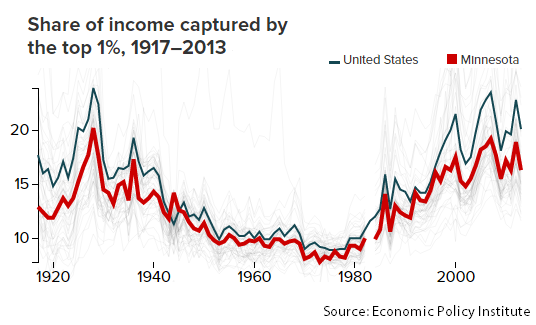Income inequality between Minnesota’s richest and poorest households continues to widen and is bad for the economy, according to a report from the Economic Policy Institute.
Income inequality has gotten worse in every state since the 1970s, and the highest-income households today hold a much higher share of overall income. Growing income inequality contradicts some of our country’s most deeply held values. Americans believe that hard work should pay off, that people who work full time should be able to support their families, and that everyone should have the opportunity to succeed. Income inequality can also be bad for the economy. When low- and middle-income households have a smaller share of the economic prosperity they help produce, it can dampen consumer spending, which is an important driver of economic growth.

Some of the most distressing findings:
- As of 2013, the top 1 percent of earners in the United States hold 20.1 percent of the nation’s income. In Minnesota, a similar story prevails where the top earners hold 16.3 percent of income.
- The income gap is now so wide that the richest 1 percent of earners in Minnesota make almost 20 times more than the bottom 99 percent.
- In Minnesota, income inequality is worst in Roseau County, where the top earners have incomes 33 times higher than the bottom 99 percent.
Fortunately, Minnesota can take actions to decrease income inequality and to push back on its negative impact on living standards. These include:
- Increasing the number of good jobs by increasing wage and job quality standards, such as boosting the minimum wage and expanding access to earned sick time;
- Ensuring our tax system doesn’t make income inequality worse, but instead is fair to Minnesotans of all income levels, through policies like expanding the Working Family Credit; and
- Supporting lower-wage workers in their efforts to move into the middle class, by making child care more affordable, improving access to affordable health care, and making sure all Minnesotans can get the education and skills training they need.
By investing the right resources in the right places, Minnesota can work to mitigate rising income inequality so that everyone has a chance to succeed.
-Clark Biegler